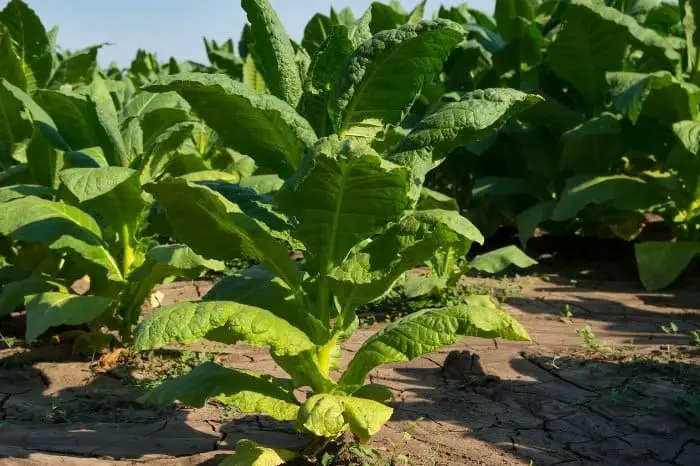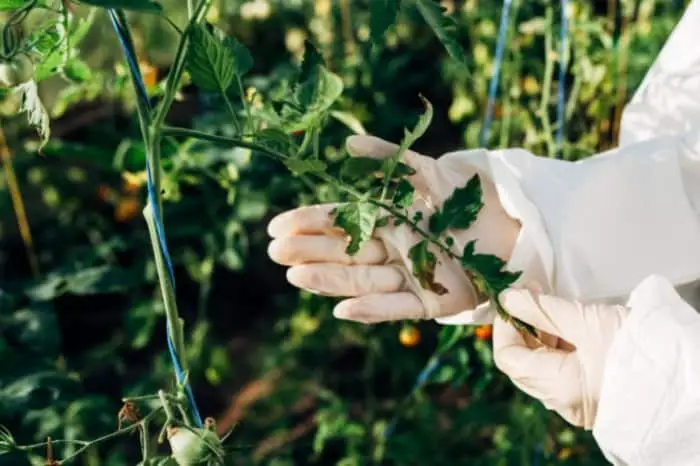Last Updated on October 30, 2022
Tomato leaves curling is one garden problem that may present itself to your garden. Experiencing tomato plant diseases curled leaves in your garden can be pretty frustrating and worrisome. But don’t stress! There are some possible remedies you can go for to help your tomato plant leaves curling and we will discuss that here.
You should however know that not all tomato plant diseases infected leaves curling are solvable. But it’s good to know that some of the tomatoes plants can be helped but others are unsolvable. You can however take some measures to avoid future occurrences of this type of situation.
This is why we would be looking at the causes of tomato plant diseases curled leaves and more.
Reasons Tomato Leaf May Curl
Tomato leaves curling is one common issue gardeners encounter. There are several reasons you may be experiencing tomato plant leaves curling in your garden. The first thing to know is that not all tomatoes curling are due to infectious diseases.
Your tomato leaves curing may be due to physiological reasons, herbicide drift or damage, as well as infestation.
- Physiological reasons are the most common and they are mostly caused by environmental stress.
- Herbicide drift or damage is caused by herbicides spreads on your plants.
- Then we have an infestation from a virus which is majorly caused by 3 viruses. They are curly top virus (spread by leaf-hoppers), tomato yellow leaf curl virus (spread by whiteflies), and mosaic virus.
For the purpose of this article, we will be looking into more details on tomato plant disease curled leaves.
Tomato Plant Diseases Curled Leaves And Possible Remedies
One culprit to your tomato leaves curling is a virus. There are 3 main viruses that can cause your tomato plant to curl. They include:
1. Curly Top Virus: Tomato Plant Diseases Curled Leaves
Symptoms: Once you notice the top portion of the plant curling upward or the whole leaves pointing upwards, it may be a sign of the curly top virus.
Curly top virus in tomato plant is caused by leaf-hoppers pests chewing your tomato plant. The pest mostly chooses one plant to chew. The good thing is that the virus won’t spread to other plants even if the infected and uninfected tomato plants are touching each other.
But when these leaf-hoppers bugs chew on an infected plant and fly to chew on another uninfected plant, chances are the leaf-hopper bugs will give the uninfected plant that virus.
You can still allow the plant to attain maturity and harvest your crop. This is if the plant is already growing fruit, the plant can still produce ripened fruit. However, if they were infected in their early stage, their growth may be stunted and ripen prematurely.
But the best thing to do is to get rid of the plant to avoid leaf-hoppers spreading the virus to uninfected plants when they chew on them.
Organic Neem Bliss 100% Pure Cold Pressed Neem Seed Oil
2. Tomato Yellow Leaf Curl
Symptoms: Leaves can curl upward or downward and the leaf can roll in a cup-like fashion. More symptoms are marginal yellowing of leaves, leaf size reduction, dropping of flowers or fruit, and stunted plant growth.
Tomato yellow leaf curl is spread by whiteflies. The best thing to do is to keep the population of whiteflies in your garden under control. You can do this by spraying neem oil once or twice every week so whiteflies won’t come close to your plant. But once the disease infected the plant and manifested, it’s hard to get rid of it.
However, you can also do this to help your plant: get a big trash bag and wrap it by covering the whole tomato plant. Then tie the open end of the bag around the tomato trunk at soil level.
Cut the plant off at the soil level and allow it to sit in the hot sun for a day or two. This will kill all the whiteflies that contain most of the virus. Then begin a neem spraying scheme after this.
3. Tomato Mosaic Virus
Symptoms: Leaves rolling upwards and coloring of leaves such as internal browning. The plant may also have stunted growth.

The best thing is to remove infected plants and get rid of them. This mosaic virus can live in the soil for up to 2 years. Therefore, when you’re watering your tomato plant, water the base and never allow water to splash over the leaves.
When you do this, it will reduce the chances of the mosaic virus getting into your plant leaves. This is just in case the mosaic virus still lives in the soil.
The best way to overcome the tomato mosaic virus is to grow resistant varieties.
Other Reasons For Tomatoes Leaves Curling
Apart from disease-related issues, tomato plant leaves can be all curled up for other reasons. We have physiological reasons which are often resolvable. Then we have the herbicide drift.
- Physiological Reasons: Physiological reasons are caused by environmental stress. This environmental stress can include heat, under watering, overwatering, dry weather, excess nitrogen application, etc. Usually, the leaves won’t change their green color but they will curl upward and most of these causes are remediable.
- Herbicide Drift: This is when you spray herbicide in your garden or you live close to where one has been sprayed, some of the residues can drift over your tomato plants. This can cause your tomato leaves to curl. Your plant may recover from this. But if they don’t it’s best you pull out the whole plant and dispose of it.

Preventive Measures For Tomato Plant Leaf Curl
Tomatoes may be easy to grow but they can as well be tricky to grow. You need to keep a close eye on your tomatoes as they grow so you don’t miss even the slightest changes that may occur. So, always watch your tomatoes plant and act as soon as you notice any problem.
Another great tip is to go for virus infestation is to plant resistant tomato varieties of these diseases.
FAQ’s
How do you treat curled tomato leaves?
Curling is a disease that affects only tomatoes. It is caused by viruses, bacteria or fungi. It appears when there is high humidity. When a plant is affected by the disease it can look like a leaf that has been rolled up. The disease can also affect the fruits.If you are treating your tomatoes for this problem, you should look for the symptoms of the disease and follow these steps:
- Check the leaves for signs of wilting or yellowing
- Look for any other problems with the leaves – they may be unevenly coloured, or they may have spots or crinkles on them
- If you can see signs of a fungal infection, there may be some mould on the leaves – if so, remove the leaves and disinfect the area where they were growing
- If you have found that the cause of your curled tomato leaves is a virus, you should first make sure that the virus is not spreading to other plants in your garden. You can do this by spraying a product called ‘Bordeaux mix’. This is a spray that contains a pesticide that kills viruses.
You can use an anti-fungal spray. You can also remove the affected leaves.
Tomato leaves can be also damaged by insects. I would recommend using Bt for them. There are many types available, some that are used against leaf feeding caterpillars and some that are used against slugs. It's best to use a combination of the two. The Bt products that are used against leaf feeding caterpillars work very well. Bt for slugs is effective at controlling them in the garden, but it will not kill the slugs in your greenhouse .
Can you cure tomato leaf curl virus?
Tomato leaf curl virus (TLCV) is one of the most devastating viruses in the world and has been present for years. It causes serious damage to tomato crops worldwide. There is no known cure for TLCV, and it is difficult to grow tomatoes without being infected by it. However, there are some ways to control TLCV, including using chemical sprays, breeding, and grafting. These methods are expensive and time-consuming.
The most common method of controlling TLCV is through the use of resistant varieties. Tomato plants that have a resistance gene against TLCV can be grown without being affected by the virus. Although the resistant varieties are available, they are not always effective in preventing the spread of the virus, and they do not always produce good yield. Insecticides are the most common way to control TLCV, but they may not be as effective as expected. The virus is carried by aphids and thrips, and they can transmit the virus to other tomato plants in the same field, or to other plants in the same garden. Insecticides that kill these pests are not 100 percent effective against TLCV, because it can be transferred to another plant through the insecticide’s residual effect. In some countries, farmers use an organic method to prevent the virus from spreading. They plant two tomato crops, one with the resistant varieties and one without. This allows the virus to remain in the soil and prevent it from spreading.
Closing Remark On Tomato Plant Diseases Curled Leaves
Tomato plants having all curled up leaves may be solvable or not. The key to solving tomato plant leave curl is to correctly identify the problem before you administer any solution.

Eunice is an enthusiastic gardener with a passion for growing beautiful flowers. She loves nothing more than spending time in her garden, tending to her plants and enjoying the outdoors. Eunice has been gardening for over 15 years and has developed a unique style of landscaping that is both practical and aesthetically pleasing. She is especially fond of growing roses and enjoys experimenting with different varieties and colors. Eunice takes great pride in her garden and often shares the fruits of her labor with friends and family. In her spare time, she enjoys reading gardening magazines and attending local horticulture events. Eunice is passionate about her hobby and is always eager to share her knowledge and experience with others.

